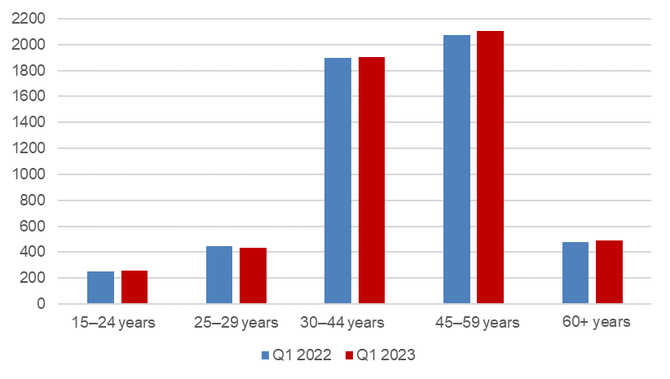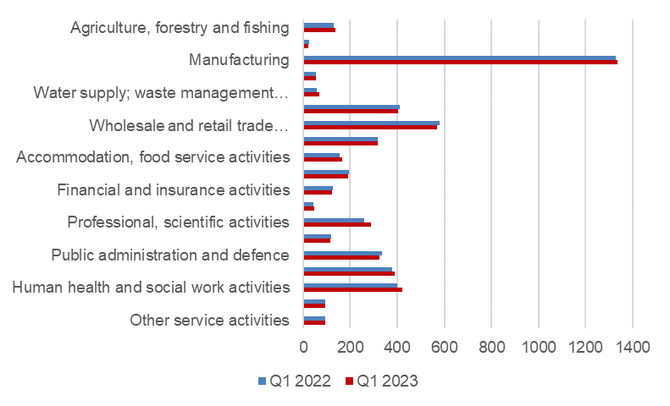Czech employment and unemployment as measured by the LFS - 1. quarter of 2023. Female employment was increasing
Female employment was increasing
Employment and unemployment in the Czech Republic as measured by the Labour Force Sample Survey – 1st quarter of 2023
The total employment increased by 55.3 thousand persons, year-on-year (y-o-y). The number of the unemployed, according to the methodology of the International Labour Organization (ILO), increased by 21.8 thousand persons. The number of the economically inactive aged 15+ years decreased by 56.8 thousand.
Employment
The seasonally adjusted average number of employed persons decreased by 4.0 thousand persons in the Q1 2023 compared to the Q4 2022.
The number of working persons aged 15+ years increased by 55.3 thousand, y-o-y, i.e. by 1.1% to 5 198.0 thousand. The increase is mainly caused by an increment in the number of working females. Their number is by 59.7 thousand higher, y-o-y. The number of working persons aged 45+ years considerably increased, by 49.6 thousand.
Chart 1: Thenumber of working persons in the national economy and their structure by age group (thousand)

Source: CZSO, LFSS
The number of employees increased by 21.1 thousand persons. The number of the self-employed (without unpaid contributing family workers) increased by 46.0 thousand persons. This overall increase is owing to an increase in the number of the self-employed without employees (own-account workers), namely by 50.4 thousand. A decrease in the number of the self-employed with employees (employers) by 4.4 thousand was not significant.
According to data for the Q1 2023, the development of employment in individual economic activities (CZ-NACE sections) in the Czech Republic was different[1]). In the primary sector of agriculture, forestry and fishing, the number of working persons increased by 6.5 thousand, year-on-year, to 136.8 thousand. In the secondary sector of industry and construction, there wasn’t any significant change in the number of working persons; their number increased by 5.1 thousand to 1 884.8 thousand. In the tertiary sector of services, the total employment increased by 40.5 thousand, y-o-y, to 3 173.2 thousand. In this sector, the number of working persons especially increased in the section of ‘professional, scientific and technical activities’ by 27.9 thousand and also in the section of ‘human health and social work activities’ by 20.3 thousand persons. Some sections, on the other hand, recorded a decrease in the number of working persons; in the ‘wholesale and retail trade; repair of motor vehicles and motorcycles’ the number of working persons decreased by 13.0 thousand persons.
Chart 2: Thenumber of working persons in the national economy by economic activity (thousand)

Source: CZSO, LFSS
Along with changes in the structure by economic activity (CZ-NACE section), also changes in the structure of working persons by occupation took place. According to the Classification of Occupations (CZ-ISCO), the number of working persons increased the most in the major group of professionals (by 46.0 thousand) and in the major group of craft and related trades workers (by 29.6 thousand). On the other hand, the biggest decrease was in the major group of plant and machine operators and assemblers (by 23.8 thousand).
Chart 3: Thenumber of working persons in the national economy by Classification of Occupations (thousand)

Source: CZSO, LFSS
The development trend in the number of working persons according to the educational attainment is also related to those changes in the employment structure. The number of working persons with tertiary education increased the most, by 31.8 thousand to 1 417.4 thousand. The number of working persons with secondary education with A-level examination decreased by 13.8 thousand to 1 885.8 thousand persons. The number of the employed with secondary education without A-level examination increased by 17.8 thousand to 1 663.0 thousand and the number of working persons with primary education increased by 20.3 thousand to 231.1 thousand persons.
The employment rate (the percentage of working persons in the age group of 15–64 years old) increased in the Q1 2023 compared to the corresponding period of the previous year by 0.6 p. p. to 75.6%. The male employment rate decreased by 0.3 p. p. to 81.6%; the female employment rate increased by 1.6 p. p. to 69.4%.
Unemployment
The seasonally adjusted average number of unemployed persons according to the ILOmethodology[2]) increased in the Q1 2023 by 30.1 thousand persons, compared to that in the Q4 2022.
The total number of the unemployed aged 15+ years increased, year-on-year. The number of the unemployed was by 21.8 thousand higher and reached 140.9 thousand persons. Primarily the number of the unemployed males increased by 14.1 thousand to 67.9 thousand. The number of the unemployed females increased by 7.7 thousand to 73.0 thousand.
The number of the unemployed increased the most in the Středočeský Region (by 6.0 thousand) and in the Liberecký Region (by 5.3 thousand).
Chart 4: The number of the unemployed in Regions of the Czech Republic (thousand)
Source: CZSO, LFSS
The number of persons unemployed for one year and longer also increased; their number increased by 3.0 thousand persons, y-o-y, in total and reached 39.6 thousand persons. However, what is significant, is the difference between males and females. Whereas the number of the long-term unemployed males increased, year-on-year, the number of the long-term unemployed females in the Q1 2023 decreased compared to the corresponding period of 2022.
Chart 5: The number of persons unemployed for one year and longer and their age structure (thousand)
Source: CZSO, LFSS
The general unemployment rate according to the ILO definition in the age group of
15–64 years old (the percentage of the unemployed in the labour force,
i.e. in the sum of the employed and the unemployed) increased, year-on-year, by
0.4 p. p. The unemployment rate in the Q1 2023 was 2.7% and in
the corresponding period of the previous year it was 2.3%.
In terms of a regional comparison, the general unemployment rate of the 15–64 years old was the highest in the Moravskoslezský Region (4.5%), in the Karlovarský Region (4.5%), and in the Liberecký Region (3.9%). The unemployment rate decreased the most, y-o-y, in the Olomoucký Region (by 1 p. p to 2.5%). The Pardubický Region had the lowest unemployment rate in Czechia (1.4%).
Chart 6: Unemployment rate of the 15–64 years old in Regions of the Czech Republic (%)
Source: CZSO, LFSS
Economic inactivity
The number of economically inactive persons aged 15+ years was by 56.8 thousand lower, year-on-year, and amounted to 3 504.7 thousand. The number of economically inactive females decreased by 58.7 thousand; the number of economically inactive males increased by 2.0 thousand, year-on-year. The number of all the economically inactive including children up to 15 years of age decreased by 60.5 thousand to 5 194.4 thousand.
In the sample survey, data are also collected on persons who do not work and do not seek a job in an active manner and therefore do not comply with the ILO conditions for the unemployed, yet they state that they would like to work. In the Q1 2023, the number of such persons was 74.0 thousand persons, i.e. by 7.0 thousand persons more than in the corresponding period of 2022. The number of persons who are willing to work, however, they are not able to start in a potential job immediately, is relatively high. Only 16.4 thousand of the persons are able to start in a job within a fortnight, at the latest.
Note:
Recalculation to the same population structure
The Labour Force Sample Survey (LFSS) is carried out in selected dwelling households. Collective accommodation establishments are not included in the survey. Results are weighted and grossed up to data of demographic statistics. For recalculation of data for the Q1 2022 and for the year 2023, demographic weights based on the 2021 Population and Housing Census results (Population of Municipalities - 1 January 2022 | CZSO) were used.
Elaborated by:
Marta Petráňová, phone number: (+420) 274 054 357, e‑mail: marta.petranova@czso.cz
Gabriela Strašilová, phone number: (+420) 567 109 071, e-mail: gabriela.strasilova@czso.cz
Unit for Labour Forces, Migration, and Equal Opportunities
[1])Data for the economic activities (CZ-NACE sections) may be influenced by the applied methodology of the Labour Force Sample Survey (LFSS). The survey only covers persons living in dwellings (flats), i.e. private households. Data for persons living in collective accommodation establishments (in which foreign nationals are often accommodated) are not measured.
[2]) The ILO methodology defines the unemployed as persons who during the reference period were without a job, did not work an hour for pay or remuneration, and were in an active manner seeking job they would be able to join within fortnight at the latest. This methodology is uniform for all EU Member States and provides internationally comparable data. It has to be taken into consideration that the definition of “the unemployed” by the ILO differs from the definition of “job applicants kept in the register of the labour offices” of the Ministry of Labour and Social Affairs.
- year 2023 | 1. quarter of 2023
- year 2022 | 4. quarter of 2022 | 3. quarter of 2022 | 2. quarter of 2022 | 1. quarter of 2022
- year 2021 | 4. quarter of 2021 | 3. quarter of 2021 | 2. quarter of 2021 | 1. quarter of 2021
- year 2020 | 4th quarter of 2020 | 3rd quarter of 2020 | 2nd quarter of 2020 | 1st quarter of 2020
- year 2019 | 4th quarter of 2019 | 3rd quarter of 2019 | 2nd quarter of 2019 | 1st quarter of 2019
- year 2018 | 4. quarter of 2018 | 3. quarter of 2018 | 2. quarter of 2018 | 1. quarter of 2018
- year 2017 | 4th quarter of 2017 | 3rd quarter of 2017 | 2nd quarter of 2017 | 1st quarter of 2017
- year 2016 | 4. quarter of 2016 | 3. quarter of 2016 | 2. quarter of 2016 | 1. quarter of 2016
- year 2015 | 4. quarter of 2015 | 3. quarter of 2015 | 2. quarter of 2015 | 1. quarter of 2015
- year 2014 | 4 quarter 2014 | 3 quarter 2014 | 2 quarter 2014 | 1 quarter 2014
- year 2013 | 4th quarter of 2013 | 3rd quarter of 2013 | 2nd quarter of 2013 | 1st quarter of 2013
- year 2012 | 4th quarter of 2012 | 3rd quarter of 2012 | 2nd quarter of 2012 | 1st quarter of 2012
- year 2011 | 4th quarter of 2011 | 3rd quarter of 2011 | 2nd quarter of 2011 | 1st quarter of 2011
- year 2010 | 4th quarter of 2010 | 3rd quarter of 2010 | 2nd quarter of 2010 | 1st quarter of 2010
Published: 17.05.2023
The data are valid as of the release date of the publication.
Contact: Information Services Unit - Headquarters, tel.: +420 274 056 789, email: infoservis@czso.cz
